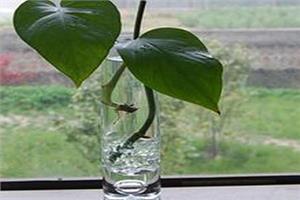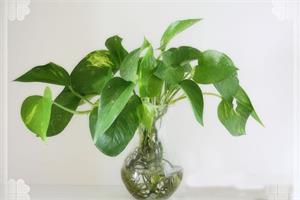The most common way of propagation of green pineapple
Soil-grown green radish can be said to be the most common way of home planting, so green radish insertion has become the most common way of home green radish reproduction. So, what's a turnip? What are the specific steps? This article gives a brief introduction to the above problems for the reference of friends interested in planting green radish.

Usually, the propagation of green radish adopts the method of insertion. At the end of spring and early summer, healthy green radish vines are selected, branches of 15 cm to 30 cm are cut off, leaves of 1 to 2 nodes at the base are removed, attention is paid not to damage aerial roots, then inserted into plain sand or coal slag, the depth is 1/3 of the cutting ears, enough water is placed in shade, water is sprayed on the leaves every day or plastic film is covered to keep moisture, as long as the environment is not lower than 20 DEG C, the survival rate is above 90%.
The specific method of insertion is as follows:
1. Selection and treatment of cuttings
The cuttings should choose semi-lignified branches with strong growth and no diseases and insect pests, cut them into 10-13 cm long, cut the lower incision into inclined mouth, leave 2-3 leaves at the upper end, cut off half of the leaves, so as to reduce water evaporation and facilitate the survival of cuttings.
2. Insert matrix
Interplanting matrix requirements loose breathable, good drainage, high humus loam or sandy soil, preferably vermiculite, so that root fast, high survival rate. Disinfect soil with 2% formalin or 5% potassium permanganate before insertion.
3. Insertion method
Soak the prepared cuttings with ABT rooting powder or indolebutyric acid, insert them into the prepared substrate, bury them in 1/2, pour water thoroughly, make the cuttings contact with the substrate closely, and then cover them with plastic film.
4. Post-insertion management
(1) Pay attention to keeping the soil moist and high air temperature after insertion. The soil humidity is about 50%, while the air humidity is 80%-90%.
(2) The shade degree of the shade shed should be kept at about 80% in the early stage of cutting, which can not only prevent direct sunlight from strong light, but also ensure enough scattered light to facilitate photosynthesis and rooting.
(3) Through the above treatment, the roots are basically rooted after 20 days, the film can be removed, and the light can be increased. At the same time, it is still necessary to pay attention to foliar spray and shade in sunny days in summer, and pay attention to cold protection in winter. After 10 days of rooting, it can be transferred to the pot for normal management.
It is said that the green radish's insertion is not very demanding for the seasons, and it is suitable for all seasons of the year. Moreover, the vitality of green radish is extremely strong, so the survival rate is also very high. It is also quite suitable for home cultivation.
Related
- Wuhan Hospital Iron Tree Blooming Result Was Instantly Frightened by the Gardener Master
- Which variety of camellia is the most fragrant and best? Which one do you like best?
- What is the small blue coat, the breeding methods and matters needing attention of the succulent plant
- Dormancy time and maintenance management of succulent plants during dormancy
- Minas succulent how to raise, Minas succulent plant pictures
- What are the varieties of winter succulent plants
- How to raise succulent plants in twelve rolls? let's take a look at some experience of breeding twelve rolls.
- Attention should be paid to water control for succulent plants during dormant period (winter and summer)
- Watering experience of twelve rolls of succulent plants
- Techniques for fertilizing succulent plants. An article will let you know how to fertilize succulent plants.



